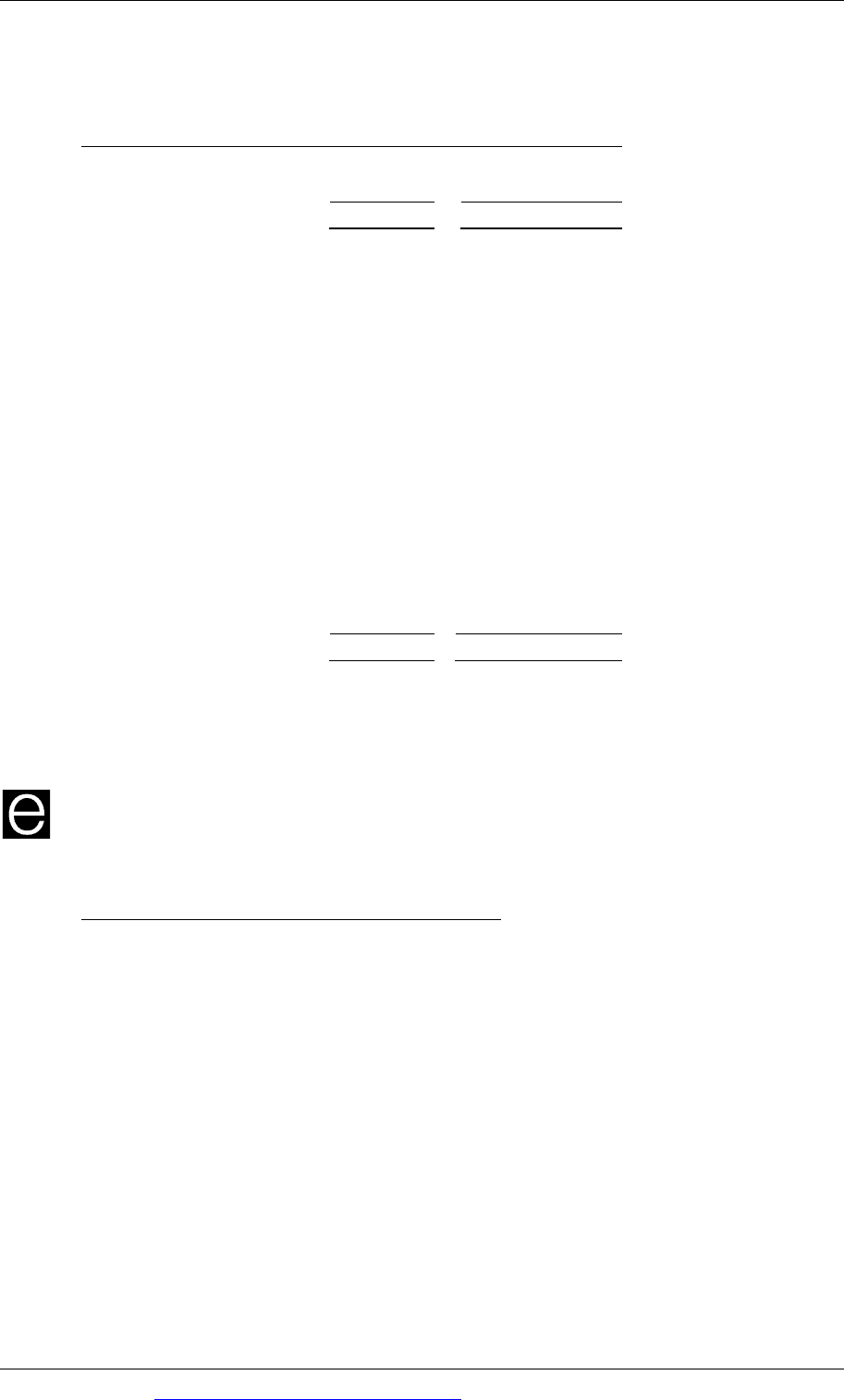ACCA F9 Financial Management - 2010 - Study text - Emile Woolf Publishing
Подождите немного. Документ загружается.


Chapter 20: Interest rate risk
© EWP Go to www.emilewoolfpublishing.com for Q/As, Notes & Study Guides 415
Conclusion: using an FRA to hedge an interest rate risk exposure
An FRA, like a forward exchange rate, therefore fixes an interest rate in advance.
An FRA can therefore be used by a borrower to hedge an exposure to a future
increase in the short-term interest rate, or to protect a depositor against a future
fall in the interest rate.
However, the user of an FRA cannot benefit from any favourable movement in
the interest rate, because the FRA fixes the interest rate and is a binding contract.
Exercise 1
A company has forecast that due to an expected cash shortage, it will need to
borrow $20 million for three months in two months’ time. A bank quotes the
following rates for FRAs:
2 v 3 3.61 – 3.59
2 v 5 3.67 – 3.63
3 v 5 3.68 – 3.65
Required
What would be the FRA agreement with the bank, and what rate would apply to the
agreement?
If the company can borrow at LIBOR + 50 basis points, what will be its effective rate
of borrowing for the three months if US dollar LIBOR is 4.50% at the start of the
notional interest period for the FRA?

Paper F9: Financial management
416 Go to www.emilewoolfpublishing.com for Q/As, Notes & Study Guides © EWP
Interest rate derivatives
Interest rate swaps
The effect of a coupon swap
Using interest rate swaps to hedge interest rate risk
Interest rate options
Types of interest rate option
Short-term interest rate futures (STIRs)
Hedging short-term interest rate exposures with STIRs
4 Interest rate derivatives
Just as there are currency derivatives for hedging or dealing in currency risk, there
are interest rate derivatives for hedging or dealing in interest rate risk. The main
types of derivative contract for interest rates are:
interest rate swaps
interest rate options, including caps, floors and collars
interest rate futures
4.1 Interest rate swaps
An interest rate swap is an agreement between two parties, such as a company and
a bank that deals in swaps (a ‘swaps bank’), for a period of time that is usually
several years. Swaps are therefore usually
long-term agreements on interest rates.
In a swap agreement, the parties agree to exchange ‘interest payments’ on a notional
amount of principal, at agreed dates throughout the term of the agreement. An
interest rate swap is therefore a contract for the exchange of ‘interest’ without an
actual loan being made.
The most common type of interest rate swap is a coupon swap. The interest rate
payments that are exchanged in a simple ‘coupon swap’ are as follows:
One party to the swap pays a fixed rate (the swap rate) on the notional principal.
The other party pays interest at a reference rate or benchmark rate for the
interest period, such as LIBOR, on the same amount of notional principal.
The exchange of ‘interest’ payments is at regular intervals, such as every three
months, six months or one year for the full term of the swap agreement.
This straightforward type of interest rate swap is called a ‘plain vanilla’ swap.

Chapter 20: Interest rate risk
© EWP Go to www.emilewoolfpublishing.com for Q/As, Notes & Study Guides 417
Example: plain vanilla swap
A company might arrange a four-year swap with a bank, for which the notional
principal amount is $20 million and:
the company pays interest every six months at a fixed rate of, say, 4.25%
the bank pays interest every six months at the six-month LIBOR rate for the four-
year period.
Since both parties pay interest every six months, if the payment dates coincide, the
swap payments will simply be settled by a net payment for the difference in rates
from one party to the other.
Over the life of the four-year swap, there will be eight exchanges of interest
payments. However, in an interest rate swap, there is no exchange of principal. The
interest relates to a notional amount of principal, not an actual loan.
If the six-month LIBOR rate for one of the periods is, say, 5.00%, the exchange of
payments would be settled by a payment from the bank to the company of
0.75% interest (5.00% – 4.25%) on $20 million for six months.
If the six-month LIBOR rate for one of the periods is, say, 3.00%, the exchange of
payments would be settled by a payment from the company to the bank of
1.25% interest (4.25% - 3.00%) on $20 million for six months.
The payments in a plain vanilla swap are at the end of each notional interest period,
therefore the amounts payable are not discounted (unlike an FRA).
Swap rates
Swap rates are the fixed rates that will be used by a bank in a coupon swap
agreement. Swap rates might be quoted as follows:
USdollar
Term Bid Ask
Years % %
1year 4.03 4.06
2years 4.17 4.20
3years 4.29 4.32
4years 4.63 4.66
5years 4.91 4.94
6years 5.14 5.17
7years 5.33 5.36
10years 5.73 5.76
15years 6.16 6.19
20years 6.35 6.38
These rates might be for a swap against three-month US dollar LIBOR. The lower
rate (the bid rate) is the rate that the bank would pay in a swap. The higher rate (the
ask rate) is the fixed rate that the bank would receive in a swap. Banks dealing in
swaps make a profit or ‘turn’ from the difference between the bid and ask rates.

Paper F9: Financial management
418 Go to www.emilewoolfpublishing.com for Q/As, Notes & Study Guides © EWP
Swap rates for the major international currencies are quoted for terms of up to 30
years.
4.2 The effect of a coupon swap
In a coupon swap, one party pays a fixed rate of interest and the other pays ‘the
floating’, which is the variable reference rate of interest, such as six-month LIBOR.
For a company with a loan or bonds in issue,
the effect of arranging a swap can
therefore be:
to swap from fixed rate interest liabilities to floating rate liabilities, or
to swap from floating rate liabilities to fixed rate liabilities.
Example
A company has a bank loan of $30 million on which it pays variable rate interest at
dollar LIBOR + 1%. The loan has five more years to maturity. The company is
worried about the risk that interest rates will soon rise, and it wants to set a limit on
its interest costs.
It might therefore arrange a five-year swap with a bank, with interest rates to
coincide with the interest payments on its bank loan.
The bank might quote rates of 5.34 – 5.39 for a five-year swap in sterling.
The company will receive the floating rate in the swap, to offset the floating rate
payments on its bank loan. It will pay the fixed rate, and the rate will therefore be
5.39%.
The swap therefore alters the net interest payments for the company as follows:
%
Actual loan payments (LIBOR + 1)
Swap receipts/(payments)
Receive the floating LIBOR
Pay the fixed (5.39)
Net interest cost (6.39)
The company had a floating rate liability of LIBOR + 1%, and has now changed this
into a net fixed interest liability of 6.39%.
On each interest payment date, the company will pay LIBOR + 1% in interest on its
bank loan, and under the swap agreement will receive or pay the difference
between LIBOR for the period and the fixed rate of 5.39%.
You might see that an interest rate coupon swap is similar in concept to an FRA, but
is for a longer period of time and covers more than one interest period.
The company might subsequently change its mind. For example, after two years, it
might decide that it wants a floating rate liability again. If so, it can go back to a

Chapter 20: Interest rate risk
© EWP Go to www.emilewoolfpublishing.com for Q/As, Notes & Study Guides 419
floating rate liability by arranging with the bank to cancel the swap and agreeing a
cancellation payment.
Exercise 2
A company has 5% bonds in issue with a nominal value of 40 million euros. The
bonds have ten more years to maturity. The company wants to exchange its fixed
rate liability for a floating rate liability in euros. A bank quotes the following rate for
a ten-year swap: 4.22 – 4.25.
By arranging a swap, what will be the effective interest cost for the company?
4.3 Using interest rate swaps to hedge interest rate risk
Interest rate swaps are used by companies to manage interest rates on their
borrowings, when the company has large amounts of borrowings at fixed or
floating rates of interest. (Swaps can also be used to manage interest rates on
interest-earning assets, in the case of investment institutions and banks). They can
therefore be a method of hedging exposures to interest rate risk.
There are three main ways in which swaps might be used to manage interest rate
risks for a company that borrows in large amounts:
to manage the proportions of fixed rate and floating rate liabilities in a
company’s overall debts
to obtain a fixed rate for borrowing when this is not possible in any other way
to obtain a more favourable interest rate through ‘arbitrage’.
Swapping interest rate liabilities
Some large companies use interest rate swaps to manage their net interest liabilities
(in each currency). For example, a company that borrows extensively, through a
combination of bank loans and bond issues, might have a policy that:
25% of its debts should be at a fixed rate
25% of its debt should be at a floating rate, and
the remaining 50% may be at a fixed or floating rate, or a mixture of fixed and
floating, depending on the judgement of the finance director or treasury
department.
The company might then use interest rate swaps to alter its net liabilities, within the
company’s policy guidelines, between fixed rate and floating rate. It might move
towards more floating rate liabilities if interest rates are expected to fall, and
towards fixed rate liabilities when interest rates are expected to rise.
The advantage of using swaps is that a company can alter its net liabilities from
fixed to floating rate or floating to fixed rate, without having to alter or re-negotiate
its actual loans or bond issues. For example, a company with fixed rate bonds can
swap from fixed to floating rate liabilities with a swap, without having to redeem
the bonds early and negotiate a floating rate loan with a bank.

Paper F9: Financial management
420 Go to www.emilewoolfpublishing.com for Q/As, Notes & Study Guides © EWP
Obtaining fixed rate liabilities
Many companies are unable to obtain fixed rate debt. Fixed rate interest liabilities
come from issuing bonds. Medium-term bank loans are normally at a floating rate
of interest. If a company is too small to issue bonds, or does not have the credit
status to issue bonds, it must borrow from banks to obtain debt finance.
If a company wants fixed rate liabilities, but can only borrow from a bank at a
variable rate, it can:
obtain a loan at a variable rate and
swap its variable rate liability into an effective fixed rate liability by means of a
swap.
Example
A company borrows from its bank for five years at LIBOR plus 150 basis points. It
wants its interest rate liabilities to be fixed, so it makes a five-year swap transaction
with a bank, in which it pays a fixed rate of 5.8% and receives LIBOR.
As a result of the swap, the company’s net interest obligations are fixed at 7.3%.
%
Loan payments (LIBOR + 1.50)
Swap payments and receipts
Receive the floating rate LIBOR
Pay the fixed rate (5.80)
Net interest cost (7.30)
Credit arbitrage
At one time, swaps were sometimes used to obtain a lower interest rate on
borrowing. This was possible because swaps banks were able to identify
opportunities for ‘credit arbitrage’. These opportunities arose because of anomalies
in the rates of interest at which different companies could borrow. Swaps could be
used to exploit these anomalies and enable companies to borrow at a lower effective
rate o finterest.
When an opportunity for credit arbitrage exists, one of the following situations will
occur.
Situation 1
Two companies want to borrow. They can both borrow at either a fixed rate or a
floating rate. Company A has to pay a higher rate of interest than Company B.
However, the difference in borrowing costs between the two companies is less for
fixed rate borrowing than for variable rate borrowing.

Chapter 20: Interest rate risk
© EWP Go to www.emilewoolfpublishing.com for Q/As, Notes & Study Guides 421
For example:
Fixed rate
borrowing cost
Variable rate
borrowing cost
Company A 7.25%
LIBOR + 1.5%
Company B 6.50%
LIBOR + 0.5%
Difference 0.75%
1.0%
Credit arbitrage is possible using an interest rate swap if Company A wants to
borrow at a variable rate of interest and Company B wants to borrow at a fixed rate.
Situation 2
Two companies want to borrow. They can both borrow at either a fixed rate or a
floating rate. Company C has to pay a higher rate of interest than Company D.
However, the difference in borrowing costs between the two companies is more for
fixed rate borrowing than for variable rate borrowing.
For example:
Fixed rate
borrowing cost
Variable rate
borrowing cost
Company C 7.75%
LIBOR + 1.5%
Company D 6.50%
LIBOR + 0.5%
Difference 1.25%
1.0%
Credit arbitrage is possible using an interest rate swap if Company C wants to
borrow at a fixed rate of interest and Company B wants to borrow at a variable rate.
Example
A bank is aware that two companies can borrow at the following rates:
Fixed Floating
Company A 5.50% LIBOR + 0.50%
Company B 6.40% LIBOR + 1%
Company A wants to borrow at a floating rate, and can do so at LIBOR + 0.50%.
Company B wants to borrow at a fixed rate, and can do so at 6.40%. However, an
opportunity for credit arbitrage exists, because company A can borrow at a fixed
rate 0.90% lower than company B, but at a floating rate only 0.50% lower than
company B. The opportunity for credit arbitrage totals 0.40% (0.90% - 0.50%).
A bank might therefore propose the following arrangement:
Company A should borrow at a fixed rate, by issuing bonds at 5.50%. Company
B should borrow at a floating rate, by obtaining a bank loan at LIBOR + 1%.
Company A should enter into a swap with the bank in which it receives 5.20%
fixed and pays LIBOR.

Paper F9: Financial management
422 Go to www.emilewoolfpublishing.com for Q/As, Notes & Study Guides © EWP
Company B should enter into a swap with the bank in which it pays 5.25% fixed
and receives LIBOR.
The net interest cost of each company would be as follows:
Company A
Company B
%
%
Borrowing cost (5.50)
(LIBOR + 1)
Swap payments
Receive 5.20
LIBOR
Pay (LIBOR)
(5.25)
Net cost (LIBOR + 0.30)
(6.25)
Company A reduces its net borrowing cost by 0.20% below the cost of borrowing
directly at a floating rate, and company B reduces its fixed rate cost by 0.15% below
the cost of issuing bonds at 6.40%. The bank makes a profit of 0.05% from the
difference between its fixed rates in the swap for receiving (5.25% from company B)
and paying (5.20% to company A).
4.4 Interest rate options
Options were explained in the previous chapter. Options on interest rates give the
holder of the option the ability to fix an effective maximum interest rate for
borrowing or a minimum interest rate on a deposit.
An interest rate option is an option on a notional loan or deposit, where the loan or
deposit period begins:
on the expiry date for the option for a European-style option, or
on or before the expiry date for the option, for an American-style option.
The option guarantees a maximum or a minimum rate of interest for the option
holder, and interest rate options are therefore sometimes called
interest rate
guarantees
or IRGs.
A call option guarantees a maximum rate of interest.
A put option guarantees a minimum rate of interest.
The maximum or minimum rate of interest guaranteed by the option is the strike
rate for the option, in comparison with an agreed benchmark rate of interest, such as
LIBOR or euribor.
Example
For example, a company might buy an interest rate call option on a six-month loan
starting in three months’ time (i.e. the option has an expiry date in three months’
time). The option might relate to a notional principal amount of $10 million, and the
strike rate might be 5%. This would give the option holder the right in three months’
time to borrow the (notional) $10 million for six months at a rate of 5%.

Chapter 20: Interest rate risk
© EWP Go to www.emilewoolfpublishing.com for Q/As, Notes & Study Guides 423
Since it is an option, the option holder can choose whether to exercise this right or
whether to let the option lapse at expiry.
An interest rate option is for a notional loan or deposit. If it is exercised, an actual
loan or deposit is not created. Instead, the option is ‘cash-settled’ by a payment from
the writer of the option to the option holder, for the difference between the strike
rate in the option and the ‘spot’ reference rate of interest (e.g. LIBOR) when the
option is exercised..
4.5 Types of interest rate option
Many interest rate options are arranged over-the-counter (OTC). These include:
borrowers’ options and lenders’ options
caps, floors and collars.
Options on interest rate futures are traded on the futures exchanges where the
interest rate futures are also traded.
Borrowers’ options
A borrowers’ option guarantees a maximum borrowing rate for the option holder. It
is an interest rate call option. The strike rate or exercise rate for the option is
compared with an agreed reference rate or benchmark interest rate, such as LIBOR.
If the reference rate of interest is higher than the strike rate when the option
reaches expiry, the option will be exercised. For example if a borrower’s option
gives its holder the right to borrow $20 million for three months at a strike rate
of 4.5% but the three-month LIBOR rate is 6%, the option will be exercised. The
option writer must then make a payment to the option holder for the difference
between the actual LIBOR interest rate (reference rate) and the strike rate for the
option.
If the reference rate of interest is lower than the strike rate when the option
reaches expiry, the option holder will let the option lapse.
A borrower’s option can therefore be used to fix a maximum effective borrowing
rate for a future short-term loan, but allow the option holder to benefit from any fall
in the interest rate up to the expiry date for the option.
An option has a purchase cost for its buyer, and the premium for the option might
be expressed either:
as an actual percentage of the notional principal amount, or
as an annual rate of interest on the notional principal amount.
Example
A company intends to borrow US$10 million in four months’ time for a period of
three months, but is concerned about the volatility of the US dollar LIBOR rate. The
three-month US$ LIBOR rate is currently 3.75%, but might go up or down in the
next four months. The company therefore takes out a borrower’s option with a

Paper F9: Financial management
424 Go to www.emilewoolfpublishing.com for Q/As, Notes & Study Guides © EWP
strike rate of 4% for a notional three-month loan of US$10 million. The expiry date is
in four months’ time. The option premium is the equivalent of 0.5% per annum of
the notional principal. For simplicity, we shall suppose that the company is able to
borrow at the US dollar LIBOR rate.
(a)
If the three-month US dollar LIBOR rate is higher than the option strike rate at
expiry, the option will be exercised. If the three-month LIBOR rate is 6%, the
company will exercise the option, and the option writer will pay the option
holder an amount equal to the difference between the strike rate for the option
(4%) and the reference rate (6%). The payment will be based on 2% of $10
million for three months. (This payment is discounted because a borrower’s
option is settled at the beginning of the notional interest period, and not at the
end of the interest period).
(b)
If the three-month US dollar LIBOR rate is lower than the option strike rate at
expiry, the option will not be exercised. For example, if the LIBOR rate after
four months is 3%, the option will not be exercised and will lapse.
These possible outcomes are summarised in the table below, assuming (for the
purpose of illustration) a spot LIBOR rate at the option expiry date of (a) 6% and (b)
3%.
LIBORrateatexpiry
6% 3%
Exercisetheoption Donotexercise
% %
Borrowforthreemonthsat 6.00 3.00
Receivefromoptionwriter (2.00) ‐
Costofoptionpremium 0.50 0.50
Effectiveinterestcost(%annualrate) 4.50 3.50
If the borrower can borrow at the reference rate of interest, a borrower’s option sets
the maximum borrowing cost at the strike rate plus the option premium cost.
Lenders’ options
A lender’s option guarantees a minimum deposit rate (savings rate) for the option
holder. It is an interest rate put option. In all other respects, it is similar to a
borrower’s option. The strike rate for the option is compared with an agreed
reference rate or benchmark interest rate, such as LIBOR.
If the reference rate of interest is lower than the strike rate when the option
reaches expiry, the option will be exercised. The option writer must make a
payment to the option holder for the difference between the actual interest rate
(reference rate) and the strike rate for the option.
If the reference rate of interest is higher than the strike rate when the option
reaches expiry, the option holder will let the option lapse.
